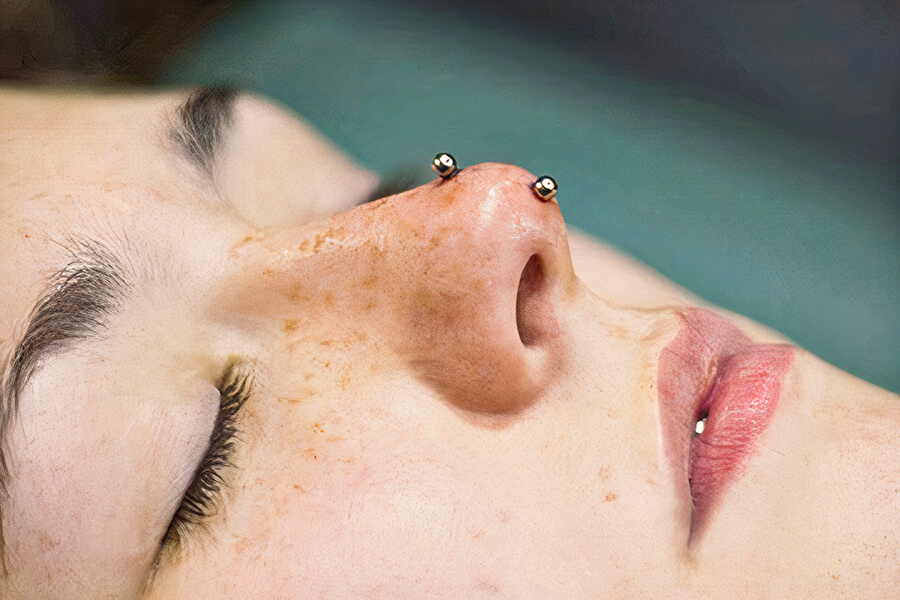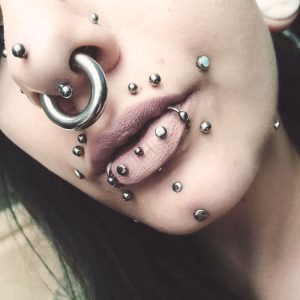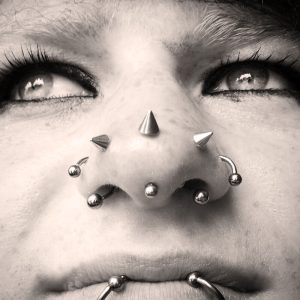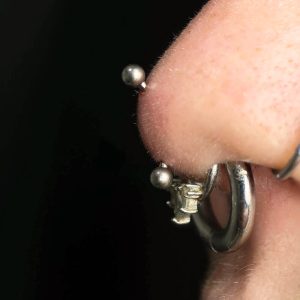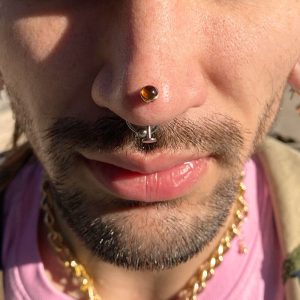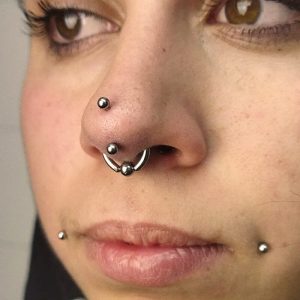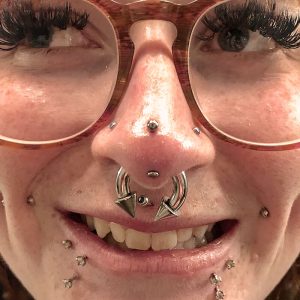Are you considering a bold new body modification that truly stands out? Look no further than the rhino piercing! This striking and unique nose piercing is an eye-catching alternative to more common options. However, before diving into this daring choice, it’s essential to understand what the rhino nose piercing entails and the challenges it presents.
In this article, we’ll tackle the problem of finding an experienced piercer for your rhino nose piercing, the agony you might experience, and the aftercare required to ensure a successful healing process. Get ready to explore the world of rhino piercings and discover if this distinctive look is the right fit for you.
Key Points
- Rhino piercing is a type of nose piercing that is very rare and unique.
- Rhino piercing is a rare nose piercing that goes through the tip of the nose.
- Although it has a long healing period 6 months to 12 months, it is possible to heal without much issue.
- Curved barbells are the most common jewelry used for this piercing.
- The most common issues with the rhino nose piercing are bumping and hitting it on things.
- The piercing is not recommended for first-timers and may leave a noticeable scar.
- You need an experienced piercer to pierce your rhino nose piercing
What is a rhino piercing?
A rhino piercing, also known as a vertical nose piercing, is a distinctive and relatively rare type of nose piercing that passes vertically through the tip of the nose. Unlike traditional nostril piercings that go through the side of the nose, rhino piercings involve the cartilage at the center of the nose.
| Piercing Type | Placement | Healing Time | Pain Level | Cost |
|---|---|---|---|---|
| Rhino Piercing | Vertical through the tip of the nose | 6-9 months | 4/10 | $50-$100 |
The depth and angle of the piercing can be customized based on the shape of your nose and personal preferences, with some individuals opting for a more upward or pointed appearance. The jewelry of choice for a vertical nose piercing typically ranges from straight to curved barbells, depending on your desired look.
Since the rhino piercing goes through cartilage, it can be a bit more painful compared to a standard nose piercing. However, the cartilage at the tip of the nose benefits from increased blood flow, which may contribute to a faster healing process compared to other cartilage piercings.
Voir cette publication sur Instagram
A Step-by-Step Guide to the Rhino Piercing Procedure
To ensure a smooth and successful process, it’s important to understand the steps involved in the rhino piercing procedure. Here’s a comprehensive guide to help you become more familiar with this unique and captivating piercing:
- Consultation: Before the procedure, you’ll have a consultation with your piercer to discuss the placement, jewelry, and aftercare. This is also the time to ask any questions you might have and address any concerns.
- Finding an experienced piercer: Rhino piercings, especially deep rhinos, require in-depth knowledge about nose anatomy and proper technique. Call around, ask if the piercer is comfortable with rhino piercings, and set up a specific appointment. It’s crucial to find a well-rated, professional piercer for this type of piercing.
- Ensuring cleanliness and comfort: When you arrive at the shop, make sure it’s clean and comfortable. You should be able to smell sterilizer in the air, and the piercer’s station should be organized and ready to go. Needles should be opened right before the piercing. Trust your instincts—if something feels off, don’t hesitate to find another piercer.
- Anatomy check: Your piercer will carefully examine the anatomy of your nose to determine the best location for the piercing. The rhino piercing is typically done between the major sections of cartilage in the nose tip, avoiding the more rigid cartilage areas.
- Marking the spot: Once the ideal location is identified, your piercer will mark the entry and exit points of the piercing with a sterilized, skin-safe marker. Make sure you’re happy with the placement before proceeding, as this is your last chance to make changes.
- Preparing the area: The piercer will then clean and sanitize the area around the nose tip using an antiseptic solution to minimize the risk of infection.
- Piercing process: Rhino piercings involve passing through more tissue than many other piercings, so the process may be more painful and take a bit longer. Instead of using piercing tongs, the piercer will swiftly take a hollow needle and thread it from the bottom of your nose through to the marked exit point. An experienced piercer is essential for this step.
- Inserting the jewelry: Once the needle is through, the piercer will seamlessly thread your chosen jewelry into your new piercing, typically a curved or straight barbell depending on the depth and angle of the piercing.
- Aftercare instructions: After the procedure, your piercer will provide you with detailed aftercare instructions to help you take proper care of your new rhino piercing and promote successful healing.
@piercingchoc #piercing #rhinopiercing #rarepiercing ♬ Funny Song – Cavendish Music
Rhino piercing pain
Cartilage piercings, like rhino piercings, typically hurt more than piercings in fleshier areas, such as earlobes or nostrils. The discomfort comes from the fact that the needle must pass through a significant amount of tissue. However, if you choose a piercer with experience in rhino piercings (which you should), the process should still be relatively quick and smooth. It might take slightly longer than a helix piercing, for example, but should not be excessively painful.
Many people who have gotten rhino piercings report that the pain was less than they expected. According to a pain scale chart that rates pain levels from 1 to 10, with 1 being the least painful and 10 being the most painful, a rhino nose piercing would typically be rated as a 4 out of 10. This means that while the piercing may cause some discomfort or numbness, it is generally well-tolerated.
To ensure the most comfortable experience possible, make sure to select an experienced piercer who is familiar with rhino piercings. They will guide you through the process and help minimize any discomfort during the procedure.
How much does a rhino piercing cost?
When considering a horizontal rhino piercing, it’s essential to understand the costs involved, which can vary depending on several factors. As rhino piercings are not as common as other nose piercings, the price may not be as easily predictable. This unique type of piercing requires an experienced piercer, which may also affect the cost.
On average, a rhino piercing may cost you around $60-$100. These prices are rough estimates and do not include the cost of the jewelry. The actual cost may vary depending on the piercer’s location and experience level.
Rhino piercing healing time and aftercare
Congratulations on your new rhino piercing! As you embark on the journey of healing your piercing, it’s essential to understand that rhino piercings generally take longer to heal than other types of body piercings due to their location and the complexity of the tissue involved. Typically, the healing time for a rhino piercing is around 6 to 9 months, but it can sometimes take up to a year or more. However, by diligently following proper aftercare, you can help ensure that the healing process goes as smoothly as possible.
-
Hands Off and Keep it Clean
First and foremost, it’s crucial to avoid touching your piercing, as tempting as it may be. Moving the piercing can disrupt the healing cells in the area and increase your risk of infection. If you need to touch your piercing for any reason, always wash your hands before and after to minimize the transfer of germs.
-
Saline Solution Soaks or Sprays
During the healing process, you should rinse your piercing site with a saline solution soak or spray at least twice a day. You can make your own saline solution by heating water and adding salt. To apply the solution, you can either dip a paper towel into the water and let your piercing sit under it for a couple of minutes or dip your piercing directly into a bowl of saline solution.
Alternatively, you can use a commercially available saline spray for a quick and convenient option. Regardless of the method you choose, rinsing your piercing site with saline solution will help keep it clean and promote healing.
-
Gently Remove Crusties
If you notice any crusty buildup around the piercing site, gently use a Q-tip dipped in saline solution to remove it after your soak or spray. Be very careful not to move your jewelry too much while doing this, as it could cause irritation or slow down the healing process.
-
Be Patient with Jewelry Changes
It might be tempting to change your jewelry soon after getting your piercing, but it’s essential to resist the urge. If you remove the jewelry too soon, you risk complications such as swelling or the piercing site healing over. Instead, be patient and wait until you’re confident that the piercing is fully healed.
-
Keep an Eye Out for Infection
If you suspect that your piercing might be infected, see a doctor immediately. Signs of infection include excessive redness, warmth, or pus around the piercing site. Infections can lead to scarring, permanent damage, or even more severe complications if left untreated, so it’s always better to be safe than sorry.
-
Follow Your Piercer’s Advice
Lastly, always follow the aftercare instructions provided by your piercer. They have the experience and expertise to guide you through the healing process effectively. By following their advice and maintaining excellent basic hygiene, you can enjoy your new rhino piercing without any complications.
Rhino piercing jewelry
When it comes to rhino piercing jewelry, selecting the right type and style is crucial for both comfort and aesthetics. Curved barbells are the most common choice for standard rhino piercings, while deep rhino piercings typically require a straight barbell. Once your piercer has confirmed that your piercing is fully healed, you can explore various options to personalize your look.
Before changing your jewelry, make sure to ask your piercer about the appropriate size. Wearing jewelry that’s too big might snag on clothing or other objects, while jewelry that’s too small could press against your piercing and potentially cause complications like jewelry rejection.
There’s a wide range of rhino piercing jewelry styles to choose from, depending on your taste and preferences. While classic ball ends are always a popular choice, you can also opt for more eye-catching options like gemstones, which can add a touch of elegance to your already unique piercing. Other interesting alternatives include barbells with mismatched ball ends, charms, opals, or pearls, allowing you to customize your rhino piercing to match your personal style.
Rhino piercing Pros & Cons
Rhino piercing is a rare vertical piercing through the tip or major ulra cartilage of the nose, typically done with a curved barbell. Here are some pros and cons to consider before getting this piercing:
Pros:
- Rhino piercing is rare and unique, making them an excellent conversation starter and a way to stand out from the crowd.
- Compared to other extreme piercings, rhino piercing generally heal well when properly cared for.
- Allows for a wide variety of jewelry styles, from traditional rhino horn looks to ornate jewelry and gem settings.
- As the piercing is not inside the nostril, it can be more comfortable than other nose piercings.
Cons:
- Rhino piercing can take several months to fully heal, requiring commitment to proper aftercare.
- This piercing is not recommended for first-timers.
- CThe exposed nature of rhino piercings makes them susceptible to getting caught on clothing or bumped, leading to potential irritation or infection.
- Finding a skilled piercer in rhino piercings can be challenging due to the rarity of the piercing.
- Removing rhino piercing jewelry may leave noticeable scars on the nose.
Voir cette publication sur Instagram
Rhino Piercing Variations: Deep, Stretched, Double, and Horizontal
If you’re captivated by the unique look of a rhino piercing and eager to explore even more distinctive styles, there are four noteworthy variations to consider: deep rhino piercing, stretched rhino piercing, double rhino piercing, and horizontal rhino piercing.
-
Double Rhino Piercing
For those seeking an even more extraordinary take on the rhino piercing, the double rhino piercing is a variation worth considering. This style involves having two rhino piercings on the same nose, creating a bold and attention-grabbing appearance. Double rhino piercings can be placed symmetrically on either side of the nose tip or slightly offset, depending on your preference and nose anatomy.
As with other rhino piercing variations, it’s essential to consult with an experienced piercer who is familiar with this unique style. They can help you determine the ideal placement for your double rhino piercings and guide you through the process safely and effectively.
-
Deep Rhino Piercing
The deep rhino piercing takes the traditional rhino piercing a step further by placing the top part of the piercing higher up in the nose. This style offers a distinctive aesthetic, but it’s crucial to proceed with caution. The cartilage in your septum is located in the center of your nose, so it’s vital to ensure the piercing avoids this area.
As a result, deep rhino piercings are often slightly crooked to accommodate the cartilage. They’re also less common than standard rhino piercings, so finding an experienced piercer with expertise in this specific piercing is a must. Be sure to thoroughly research both your piercer and the piercing itself before making an appointment.
-
Stretched Rhino Piercing
For those who already have a rhino piercing and are looking to make an even bolder statement, a stretched rhino piercing could be the ideal choice. This variation involves gradually enlarging the piercing hole to accommodate larger jewelry, creating an even more striking appearance.
Stretching any piercing takes time, patience, and professional guidance to ensure the process is done safely and with minimal risk to the tissue. It’s crucial to invest in high-quality, hypoallergenic jewelry designed specifically for stretched piercings as you progress through the stretching process. Proper aftercare remains vital even after your rhino piercing has fully healed, especially as you stretch it.
-
Horizontal Rhino Piercing
The horizontal rhino piercing is another unique variation that can add an intriguing flair to your nose. Instead of the traditional vertical positioning, the horizontal rhino piercing is placed horizontally across the tip of the nose, with the entry and exit points on opposite sides. This creates an eye-catching and unconventional look that sets it apart from other rhino piercings.
Voir cette publication sur Instagram
Rhino Piercing Images Gallery
The rhino piercing is a bold and unique statement that may not be suited for everyone, especially those new to piercings. However, if you’re passionate about embracing this daring look and feel prepared to handle the commitment, a rhino piercing can be an extraordinary addition to your personal style. Just remember to carefully consider the piercing’s impact, consult with an experienced piercer, and follow proper aftercare practices to ensure a smooth and successful experience. With the right attitude and dedication, you can rock your rhino piercing and showcase your individuality with pride.
FAQ
Are rhino piercings safe?
Rhino piercings are generally safe when performed by an experienced and knowledgeable piercer.
How to cahnge and remove a rhino piercing?
To change or remove a rhino piercing, it’s best to wait until the piercing is fully healed, which typically takes around 6 to 9 months or longer. Once healed, you can gently unscrew or unfasten the jewelry and replace it with a new piece. If you’re unsure about how to change the jewelry, consult your piercer for assistance to avoid damaging the piercing or causing discomfort.
Can I get a rhino piercing if it’s my first time getting a piercing?
While a rhino piercing might not be the best choice for first-timers due to the level of pain and healing time involved, if you’re determined and well-informed about the process, there’s no reason you shouldn’t go for it.
How do I choose the right jewelry for my rhino piercing?
When selecting jewelry for your rhino piercing, consider factors such as the material, size, and style. It’s important to choose hypoallergenic materials like titanium, surgical steel, or niobium to minimize the risk of irritation or allergic reactions.

